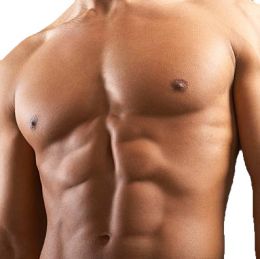 What you eat before you suit up for the gym can have a profound effect on your performance and results. There’s no shortage of pre-workout supplements out there that all claim to help you build muscle, gain strength, or burn body fat. But do any of those workout boosters you see in muscle magazines actually benefit your muscles?
What you eat before you suit up for the gym can have a profound effect on your performance and results. There’s no shortage of pre-workout supplements out there that all claim to help you build muscle, gain strength, or burn body fat. But do any of those workout boosters you see in muscle magazines actually benefit your muscles?
In my previous interviews with nutrition savant, Ori Hofmekler, we covered post-workout nutrition and thyroid health. So now it’s time for Ori to set the record straight with regard to pre-workout nutrition. Get ready for some surprising revelations!
CW: Ori, is it true that you’ll burn more fat if you train in a fasted state? Is this equally true for cardio and strength training?
Ori: In theory, fat burning is maximized when you train in a fasting state. That’s because exercise while fasting forces a fast depletion of glycogen and an increased utilization of fatty acids for energy. Furthermore, this regimen improves insulin sensitivity, which is essential for burning fat and maintaining a lean body. Nonetheless, training while fasting has a serious drawback: it compromises your peak strength and durability. Apparently with a more profound effect on strength.
CW: So is there any viable way to maximize fat burning without compromising your strength?
Ori: Yes, indeed. In fact you there are two good options. First, you can use whey protein as a pre-exercise meal, about 30 minutes before training. Whey protein serves as the ideal fuel for your muscle during prolonged intense exercise and there’s evidence that it actually increases your capacity to burn fat during and after exercise.
CW: That’s pretty exciting to hear. Please explain the mechanisms involved.
Ori: First, whey protein is the richest natural source of branched chain amino acids (BCAAs), which primarily serve as a muscle fuel substrate via the alanine-glucose pathway. This pathway is your body’s most cost-effective fueling system. It converts BCAAs into glucose in the liver which is then released to your muscle in exactly the amount your muscle needs without overly-spiking insulin. Hence, whey protein enables you to sustain prolonged intense performance in times of carb deprivation and glycogen depletion. Also, whey protein allows you to perform at a higher intensity for longer periods of time so you’ll burn more energy and fat than training while fasting.
For that purpose I use 2 scoops of grass-fed whey 30 minutes before training.
CW: Ori, since I consult with you on a regular basis, I know what the second option is and I think people will be surprised and excited to hear it. Fire away!
Ori: Yes, the second option will surprise many people. An excellent pre-exercise snack is dark chocolate. I’m talking specifically here about the kind with no sugar added. Chocolate has the highest concentration of flavonoid polyphenols, which, along with energy boosting co-factors yield the most powerful antioxidant, anti-inflammatory, and energizing effects on your muscle. Furthermore, cacao demonstrates fat burning properties, and it has the most profound effect on boosting nitric oxide, which is essential for the regulation of muscle performance, repair, and growth.
CW: Over the last few years, nitric oxide-boosting supplements have become the rage amongst strength and muscle-building athletes. Can you talk a little about nitric oxide, its role, and is it beneficial to boost it while training?
Ori: Nitric oxide (NO) is a small molecule that functions as a modulator of muscle function, and it participates in the process of muscle repair and growth. The enzyme that produces NO – nitric oxide synthase (NOS), plays an essential role in the regulation of blood flow (vasodilation), force development, and muscle contractile properties. Nitric oxide triggers gene expression and growth factors that facilitate muscle fiber repair after mechanical stress or injury. In addition, it promotes insulin sensitivity and regulates testosterone production via the NO-cGMP pathway.
CW: Wow, since dark chocolate boosts NO production, and since NO helps repair damaged muscle while potentially boosting testosterone and improving insulin sensitivity it sounds like chocolate could also be an ideal post-workout supplement.
Ori: Correct, that’s why I also use it after the first post-workout feeding of pure Warrior Whey.
CW: Are there any side effects from boosting NO too high?
Ori: Yes, NO may act in your body like a double-edge sword. Nitric oxide’s metabolism yields some of the most deleterious free radicals in the form of oxidized nitrites and peroxynitrites. These are highly reactive molecules that, when in excess, lead to accumulated oxidative stress, inflammatory disorders, mitochondrial and DNA damage, lipid per oxidation, insulin resistance, and impaired energy production.
CW: That sounds pretty bad, indeed.
Ori: Unfortunately, the story gets even worse with excessive or chronically elevated NO: it can inhibit testosterone production. Accumulated excess of its free radical metabolites have been shown to cause damage and destruction of the Leydig cells that produce testosterone. This, by the way, is one of the reasons why testosterone production is shattered during chronic inflammatory disease, or after steroid abuse.
CW: I always suspected that those NO-boosting supplements you see in newsstand muscle magazines were garbage, that’s why I never used them. Am I correct?
Ori: The problem with those NO-boosting products is that they’re typically formulated to boost NO, but are not designed to protect your body against its toxic metabolites and related side effects that I just mentioned.
Virtually all NO-boosting supplements are made with free form amino acids and synthetic ingredients that are applied in excessive dosages that don’t fit human biology. If you shove in stuff that artificially boosts NO to unnatural levels, sooner or later you may experience those side effects.
CW: Well, I certainly haven’t seen any fine print in those muscle magazines that state the side effects you mentioned. Now we know why they kept that info out.
Ori: You’re right, Chad. You can’t expect to get this information in muscle magazines because their livelihood depends on advertising money from these same companies.
CW: So we know now that boosting NO production can be beneficial, but we must not boost it too high with any of those NO-boosters you see in muscle magazines because you might eventually experience just the opposite of what you’re after. Is there any natural alternative to those supplements? Is there a natural, effective way to get the full benefits of nitric oxide?
Ori: Yes, by eating chocolate with no sugar added. Chocolate is not just the most viable NO-boosting food, it actually helps protect your body from the side effects of its metabolites by binding and neutralizing these free radicals.
Indeed, chocolate has been associated with reduced inflammation, improved blood circulation, and enhanced cardiac function. It’s also been attributed as an immune supportive, muscle repairing, and libido-boosting food. And based on recent reports, chocolate has been demonstrating insulin sensitizing and weight loss promoting properties.
CW: Wow, people are going to love to hear that the right kind of chocolate can provide so many benefits from fat loss to muscle growth.
Ori: Yes, I believe that along with whey protein, chocolate is probably the most effective functional food for your muscle before and after exercise. The problem is that virtually all chocolates today are made with sugar, fructose, synthetic sweeteners or chemical alkali. All of those additives negate the benefits of chocolate.
This is why we created our new innovative whey chocolate product – ChocoWhey. This chocolate treat combines all the benefits of whey and chocolate into one product. It’s made with no sugar or alkali added and based on my experience, if you use it as a pre-exercise snack, you’ll certainly notice the difference in your muscle performance and overall conditioning.
CW: I’ve definitely noticed that I’m stronger and sustain my strength for longer periods of time when I use ChocoWhey before training. Tell the readers how you recommend they take ChocoWhey.
Ori: I eat 3-4 nuggets or half a bar (30 grams) 10-15 minutes before training. And then, for post exercise, I eat 5-6 nuggets or one 2-ounce bar about 30 minutes after my first whey recovery meal. Whenever I have a training workout that’s a few hours long, I eat ChocoWhey bites before, during breaks, and after the training session, a few bites at a time.
ChocoWhey consists of 45% whey protein and 55% dark chocolate. This product can nourish, energize, and naturally boost NO in your muscle, acting as both an anti-inflammatory and anabolic food.
CW: Thanks again Ori for another fascinating interview!
Ori: It’s my pleasure, Chad.
Who would’ve guessed that research is accumulating to support the use of chocolate as a super food? And Ori made it even better by combining it with his outstanding whey protein. ChocoWhey not only tastes incredible, but it could be the missing link for helping you build a bigger, leaner, stronger body!
Ori’s Workout Nutrition Protocol
30 minutes before training: 3-4 nuggets or 1/4 bar >85% cocoa chocolate
30 minutes after training: 3 scoops of grass-fed whey
30 minutes later: 5-6 nuggets or 1/2 bar >85% cocoa chocolate
Stay Focused,
CW

